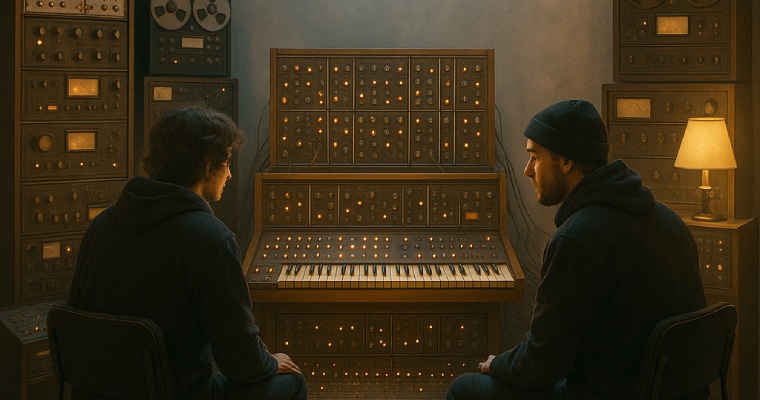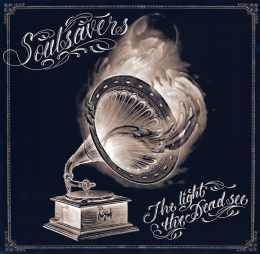
Who Are The Soulsavers?
The interesting thing about The Soulsavers is that they often work with collaborators and guest vocalists who often take the center stage. And in many cases, The Soulsavers avoid the spotlight and focus their attention on their work. As such, it is quite possible to miss out on the people who are to thank for all the beautiful sounds the band creates. So, how about we highlight the brains behind the music?
This band comprises a powerful duo with Rich Machin on one side and Ian Glover on the other. Here are some quick facts about them:
- Rich Machin. Rich, who comes from Stoke-on-Trent in England, has always been interested in music and had a background in electronic music and remixing even before becoming a core part of the Soulsavers. As such, he is the primary producer in the band, and his work mainly revolves around mixing, layering, and shaping the music. Thanks to his prior experience and zeal to try different sounds, he is able to work with different genres and has been able to integrate everything from downtempo electronica to gospel rock in his music, thus creating emotionally rich sounds. Besides working on the band’s pieces, he has worked on films, including BattleGround: 21 Days on the Empire's Edge.
- Ian Glover. As a lover of remixing, Ian fits in well with Machin’s approach to music. And together, the duo creates beautiful collaborative pieces that elevate the original sounds and give them a new twist. As the co-producer in the team, who also knows how to work with different instruments, Ian is able to contribute greatly to the musical arrangement as well as the technical production, making him an essential part of the team. He especially excels in making subtle changes to pieces that add depth and texture without taking over the entire sound.
Having worked together for decades, Ian and Rich have a beautiful chemistry that enables them to work together in creating masterpieces. Since their focus is often on the feelings that the music evokes, they have often said that they allow the music to reveal itself. This way, they are able to create music that feels so personal that even their collaborators and guest vocalists are able to convey the emotional messages with ease. To ensure that their messages land, they use minimalist album covers with symbolic images that feature loss and redemption, which appeal to fans on spiritual journeys.
The Making of the Band
The Soulsavers have been on a long and rewarding journey that started back in the early 2000s, with their year of formation being around 2000 to 2001. To showcase their evolution, we will split their history into three phases, as follows:
The Electronic Era.
When the band first started, they mainly focused on fully programmed records with no live instruments, leaning on electronic music for the most part. In fact, their first record, which dates back to 2003, was fully programmed and featured all the makings of electronic remixing and production. At this time, they remixed music from other artists, including those from Starsailor, Doves, and Death in Vegas. In these tracks, they focused more on downtempo electronics with trip-hop and ambient influences.
They soon ventured into collaborating with other artists as they wanted to create music that resonated with their audience. And it was along these lines that they featured Josh Haden on vocals in their first full-length album released in 2003, which was named Tough Guys Don’t Dance. Following this album’s success, the band invested even more in collaborations, which explains the next two phases.
The Mark Lanegan Era.
Seeing that having a backup singer engaged their audience more and enabled the band to have a wider reach, the Soulsavers brought Mark Lanegan on board. He was an American rock vocalist who had been working with the Screaming Trees. In his new role, he was the face of the Soulsavers’ 2007 Album, which was titled ‘It's Not How Far You Fall, It's the Way You Land.’ The songs in the album took on sounds inspired by rock and gospel genres, which was quite new and inspiring. Fans loved the darker vibes, and the album sold like hot cakes.
Mark Lanegan stayed on with the band for the next few years as a vocalist. He was also heavily involved in writing the material for the next album. And so, when Broken came out in 2009, fans could tell that there had been a change in the band’s approach. The album featured Lanegan’s deep, gravelly baritone that was a perfect match for the band’s emotionally tugging soundtracks. And soon enough, more rock fans started paying attention to the band.
The Dave Gahan Collaboration

As time went by, The Soulsavers went on many tours. And at some point, their bass player (Martyn LeNoble, who once played for Jane’s Addiction) introduced them to Dave Gahan. Later on, the band got to go on tour with Depeche Mode in 2009, where they got to know more about Gahan. So, by 2012, when the band needed to tweak its approach, they had already struck a rapport with Gahan and knew that he would be a good fit. This time, they were working on The Light The Dead Sea, which came out in 2012. Gahan wrote the lyrics and the Soulsavers wrote the music, thus allowing each person to shine where they excelled. As they expected, the album was a success. So, they worked together again on the album Angels and Ghosts, which came out in 2015. And they also joined hands in working on Imposter, which came out in 2021. Thanks to these collaborations, they were able to create music that was not only redemptive but cinematic, thus earning them a huge following from Mark Lanegan and Depeche Mode fans.
Additional Collaborations.
While we have mentioned the biggest collaborations to date, it is important to note that the Soulsavers have worked with many other artists over the years. For example, in their tours, which feature live shows, they often bring on board other musicians, including backup singers who bring out the general vibe of their music. The band is especially known for bringing on diverse guests, including the following big names:
- Will Oldham.
- Mike Patton.
- Jason Pierce.
- Gibby Haynes.
- Richard Hawley.
Thanks to these and other collaborations, the band has slowly moved away from only electronic music to feature many other sounds. Their evolution has been a journey that continues to highlight the beauty of the evolution of sound.
The Origin of the Name
The name The Soulsavers is quite unique, and many fans have often wondered just how the band came up with it. Well, here is the interesting bit. The band’s core members have yet to reveal how they decided on the name, and there are no official comments from them that hint at what it could mean. However, their music speaks for itself. At its core, it has spiritual and healing sounds that are akin to the sounds of redemption. In fact, many of their fans feel like they are going through a spiritual journey each time they listen to the music. So, it could be that the name Soulsavers ties to the idea of saving souls through music that often moves and comforts their audience.
Are They a Touring Band?
Just as The Soulsavers differ from other bands in their composition, their tours are also quite different. You see, they are not a touring band per se. Instead, they perform selectively, often choosing to work with guest vocalists who can bring out the emotional depth of their music. But that’s not all. Their music does not stagnate. Instead of showcasing the same pieces time and again, they ensure that their music evolves by collaborating with different artists. This way, each of their albums adds something new to their repertoire and feels like a new chapter with new voices and moods.
Successes Beyond the Stage
Besides working on new albums that transform their fans with each note, the band also works on film scores. As such, they have made a lot of headway in cinematic productions. Some of their work has even shown up in TV shows like Grey’s Anatomy and Friday Night Lights.
